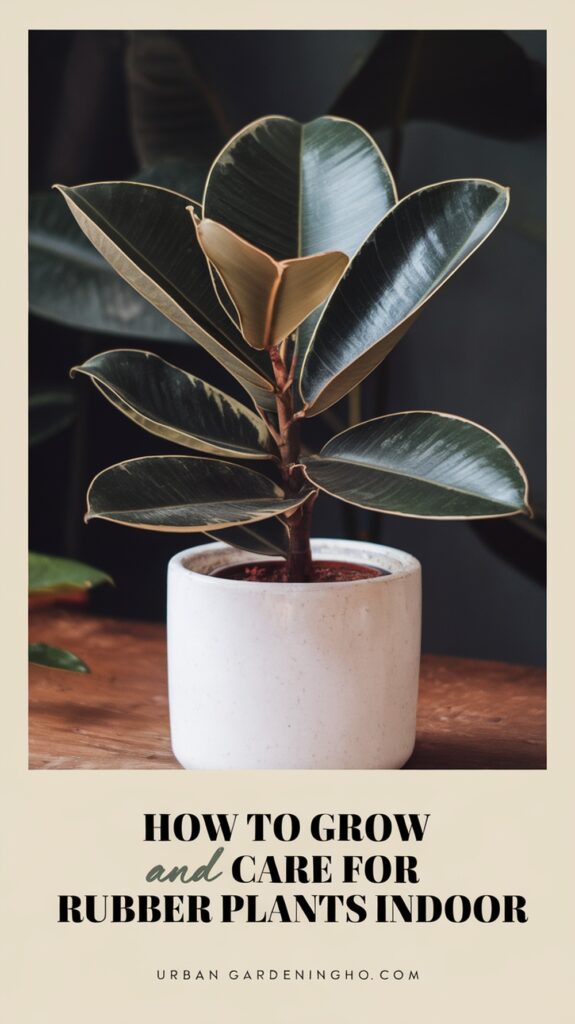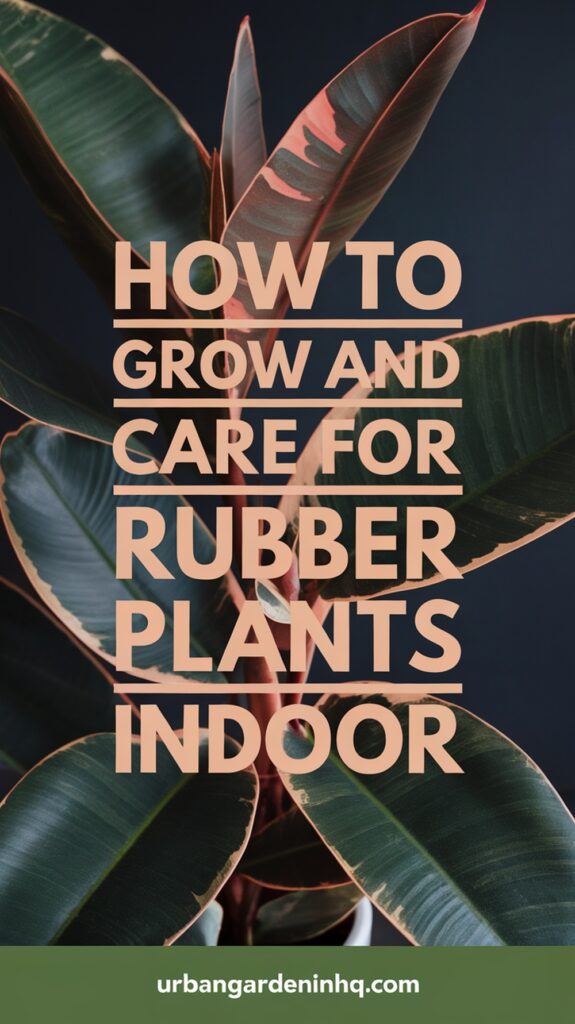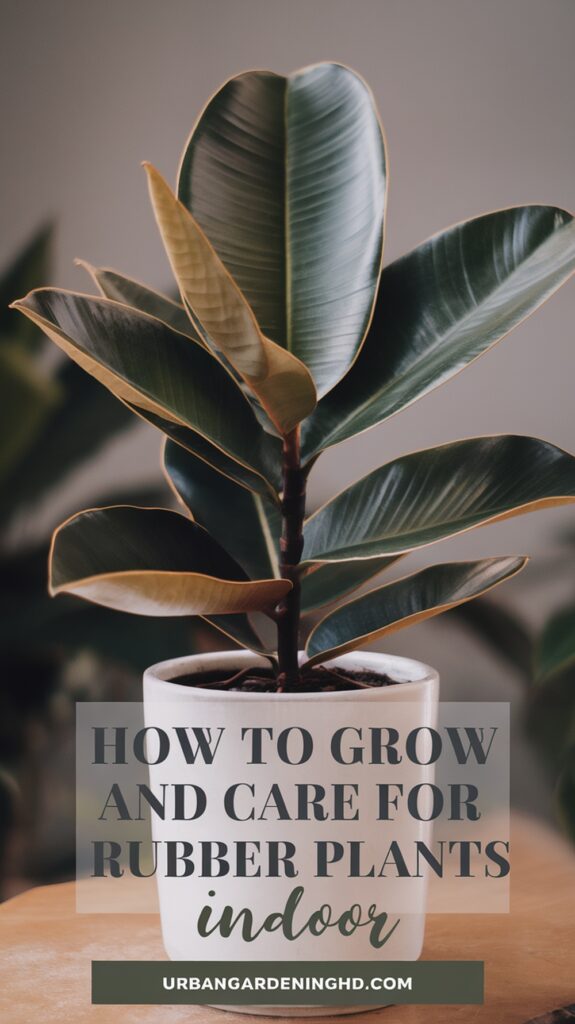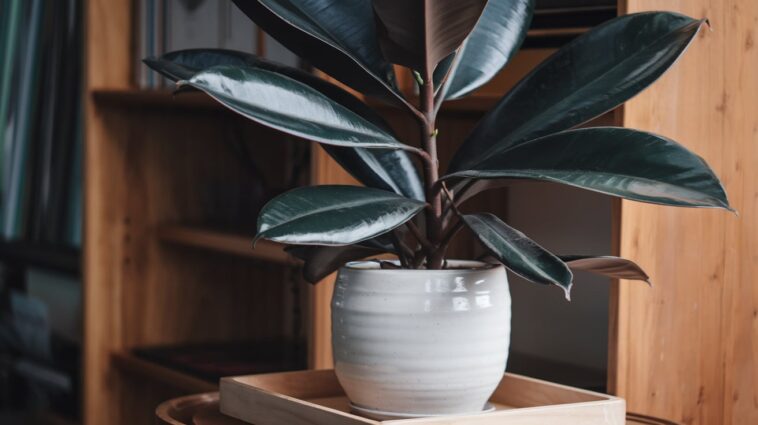I’m excited to share my knowledge on rubber plant care with you. This will help you create a thriving environment for your indoor plants. As a fan of houseplants, I’ve learned that with the right techniques, anyone can become a successful plant parent.
In this guide, we’ll explore the essentials of rubber plant care. We’ll cover everything from the basics to troubleshooting common issues. This will make it easy for you to keep your rubber plant happy and healthy.
Whether you’re a seasoned gardener or just starting out with your first houseplants, I’ll provide you with the confidence and knowledge to care for your rubber plant. We’ll cover everything from understanding your plant’s needs to finding the perfect spot for your indoor plants. We’ll ensure you have the best tips and tricks for rubber plant care.
Understanding Your Rubber Plant

To care for your rubber plant well, knowing its origins and traits is key. As someone who loves houseplants, I’ve found that understanding a plant’s natural home and growth habits is vital. This knowledge helps me meet its specific needs for it to flourish.
The rubber plant, or Ficus elastica, comes from Southeast Asia. It can grow up to 100 feet tall in the wild. But as a houseplant, it usually reaches 6-10 feet. It’s important to consider its natural growth and provide the right space and care.
What is a Ficus elastica?
Ficus elastica is a fig tree known for its large, dark green leaves. It’s a favorite houseplant because it’s easy to care for and looks great. Choosing the right rubber plant variety can greatly affect its care and upkeep.
Natural Habitat and Growth Patterns
In its natural setting, the rubber plant thrives in warm, humid climates with lots of sunlight and water. To mimic these conditions indoors, give it bright, indirect light and a steady watering schedule. Following these tips will help your rubber plant grow well and look beautiful.
Different Rubber Plant Varieties
There are several rubber plant varieties, like the standard green leaf, variegated leaf, and compacta. Each has its own look but needs similar care. Here’s a quick rundown of the main differences:
- Standard green leaf: This variety is the most common and has large, dark green leaves.
- Variegated leaf: It has leaves with yellow or white markings and is chosen for its striking look.
- Compacta: This is a smaller version of the rubber plant, perfect for small spaces or containers.
Knowing about the different rubber plant varieties and their unique traits helps you give your plant the best care. This way, you can enjoy its stunning foliage for many years.
Essential Light Requirements for Healthy Growth
As a rubber plant owner, I’ve learned that the right light is key for growth. Most rubber plants like bright, indirect light. Direct sunlight can burn the leaves, so filtered light is best.
To find the perfect spot for your rubber plant, use a light meter. It shows where the light is just right. When you’re propagating, light matters too. The right light can help your plant grow from cuttings or air-layering.
Yellow leaves or slow growth can mean your plant isn’t getting enough light. Here are some tips to get it right:
- Put your rubber plant near an east- or west-facing window for bright, indirect light.
- Use a sheer curtain to filter direct sunlight and prevent scorching.
- Avoid low-light spots to prevent weak and leggy growth.
With the right light, your rubber plant will thrive. Keep an eye on how it reacts to light. Move it if needed to avoid problems and ensure successful growth.
Watering Your Rubber Plant
Watering is key to keeping your rubber plant healthy. It’s a vital part of indoor plant care. Getting the watering right is important for your plant’s growth. Here are some easy tips to help your rubber plant thrive.
Start by checking your home’s humidity and temperature. Stick your finger into the soil up to the first knuckle to see if it’s dry. Use warm water to avoid shocking the roots. Here are some important tips for watering your rubber plant:
- Water your rubber plant when the top inch of soil feels dry to the touch
- Avoid getting water on the leaves to prevent fungal diseases
- Use room-temperature water to prevent shocking the roots
By following these tips, you can keep your plants happy and healthy. Too much water can cause root rot, while too little can dry out the leaves. With the right care, your rubber plant will grow well, making your home beautiful.
Soil and Fertilization Guidelines

I love taking care of my houseplants, and I know how key soil and fertilization are. For my rubber plant, I use a potting mix made for indoor plants. This mix drains well, preventing waterlogged soil that can harm my plants.
To keep my rubber plant healthy, I fertilize it with a balanced fertilizer during the growing season. I make sure to dilute it to half the recommended strength to avoid harming the roots. I also use a fertilizer made for houseplants to give it the nutrients it needs for strong growth and beautiful leaves.
Here are some important tips for soil and fertilization:
- Choose a potting mix that drains well.
- Fertilize with a balanced fertilizer during the growing season.
- Dilute the fertilizer to prevent root burn.
- Use a fertilizer made for houseplants.
By following these tips, I can make sure my rubber plant gets the nutrients it needs. This way, it stays healthy and adds beauty to my home.
Temperature and Humidity Needs
As a rubber plant owner, I’ve learned that the right temperature and humidity are key. The optimal temperature range is vital for your plant’s health. Rubber plants love a warm spot, with temperatures between 65-75°F (18-24°C). This makes them perfect for indoor spaces.
To keep humidity right, I use a humidifier, mainly in dry winter months. Another trick is to put the plant on a tray with water and pebbles. This boosts the humidity around the plant. It’s great for indoor plants that need more moisture.
Here are some key considerations for temperature and humidity management:
- Optimal temperature range: 65-75°F (18-24°C)
- Humidity level: 50-60%
- Using a humidifier or a water tray with pebbles to maintain humidity
By following these tips, you can create a great environment for your rubber plant. Make sure to adjust the temperature and humidity with the seasons. This will keep your plant healthy and happy.
| Season | Temperature Adjustment | Humidity Adjustment |
|---|---|---|
| Winter | Reduce temperature by 5-10°F (3-6°C) | Increase humidity to 60-70% |
| Summer | Maintain optimal temperature range | Reduce humidity to 40-50% |
Pruning and Maintenance Techniques
As a houseplant owner, I know how important regular care is. Pruning is key to keeping my rubber plant healthy. It helps shape the plant and encourages new growth. By cutting off dead or damaged parts, I stop diseases from spreading and make the plant look fuller and more vibrant.
Using clean and sharp tools is a must to avoid spreading diseases. Cutting just above a node helps the plant grow new leaves. Here are some more tips for pruning:
- Prune your rubber plant during the spring and summer months when it’s actively growing.
- Remove any weak or spindly growth to maintain the plant’s shape and promote healthy growth.
- Use gloves when handling your rubber plant to prevent the sap from causing skin irritation.
By following these tips and regular care, my houseplants, including the rubber plant, stay happy and healthy. Pruning and maintenance are key to keeping your rubber plant looking great. Make sure to include them in your routine.
Common Rubber Plant Problems and Solutions
As someone who loves indoor plants, I’ve seen my share of issues. Rubber plants often face problems like yellow leaves, droopy stems, and pests. It’s key to spot these problems early and use the right care tips.
Checking your plant regularly for stress or disease signs is important. Yellow leaves might mean you’re watering too much or too little. Fixing this by adjusting your watering and ensuring good drainage can help. For more info on rubber plant problems and solutions, check out indoor plant care resources.
Leaf Issues and Fixes
- Yellowing leaves: adjust watering schedule and ensure proper drainage
- Droopy leaves: check for pest infestations or underwatering
Pest Management
Pests can be a big problem for indoor plants. Regularly checking your plant for pests like spider mites or mealybugs is key. Using insecticidal soap or neem oil can help manage pests and keep your plant healthy.
Propagation Methods

I’ve started to care for my rubber plant and got interested in plant propagation. This lets me share my plant with friends and grow new ones. One top way to do this is by using stem cuttings. I take cuttings that are 4-6 inches long, with at least two nodes, and remove the lower leaves.
Then, I plant them in a pot with a mix that drains well. I keep the soil moist and warm until roots grow.
Another way is air-layering, which roots the stem while it’s on the mother plant. It’s a bit tricky but ensures a strong root system. For better results, I use a rooting hormone. Some plants, like rubber plants, can also be divided to create new ones.
Here are some key steps for successful plant propagation:
- Choose healthy stem cuttings with at least two nodes
- Remove lower leaves to prevent rot and promote rooting
- Use a well-draining mix to prevent waterlogged soil
- Keep the soil moist and warm until roots develop
By following these tips and using the right methods, I can grow my rubber plant and enjoy new ones. Whether you’re new to gardening or experienced, plant propagation is fun and rewarding. It lets you share your plants and create a beautiful indoor garden.
Conclusion: Growing a Thriving Rubber Plant
With the right approach and dedication, your rubber plant can thrive. It will become a beautiful addition to your home. Follow the tips and tricks in this guide to grow a healthy, vibrant rubber plant.
Remember, your rubber plant needs the right light, careful watering, and a warm, humid environment. Regular pruning and maintenance will also keep it looking great.
As you continue to care for your plant, refer back to this guide for advice or troubleshooting tips. With the right knowledge and care, you can enjoy a thriving rubber plant for years.


